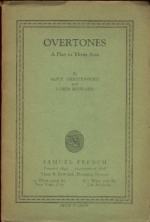|
This section contains 311 words (approx. 1 page at 400 words per page) |

|
Overtones Summary & Study Guide Description
Overtones Summary & Study Guide includes comprehensive information and analysis to help you understand the book. This study guide contains the following sections:
This detailed literature summary also contains Bibliography and a Free Quiz on Overtones by Alice Gerstenberg.
Alice Gerstenberg's Overtones is considered the earliest example of a play that dramatizes the unconscious on stage. In it, Gerstenberg uses two actresses for both Margaret and Harriet to represent the single character of Margaret and Harriet. Each embodies a disparate part of the character's personality; or, to put it in Freudian terms, one is the id and the other the ego. In Overtones, Harriet and Margaret are the cultured and refined selves, while Hetty and Maggie represent the wild, primitive desires of these same women. Using two women to play one character was a unique convention that had not been seen before. This new technique, along with Gerstenberg's ability to write witty, interesting dialogue made the play an instant success. Overtones was first produced November 8, 1915, by the Washington Square Players at the Bandbox Theater in New York. At the time of its production, Sigmund Freud had recently made his first trip to the United States, and the publication of his works had spread interest in the workings of the unconscious mind. Freud's theories were a common topic of discussion and the play capitalized upon this fad. The play influenced many later playwrights including Eugene O'Neill, who used a similar technique in his play Strange Interlude.
Overtones was Gerstenberg's second New York success. Earlier that same year, she had received accolades for her adaptation of Alice in Wonderland. Overtones was to become her most popular and most widely produced play, however. It was presented by numerous theatres across the country, had a successful run on vaudeville, and was performed in London by the great actress Lily Langtry. Overtones was originally published in 1921 in Gerstenberg's Ten One-Act Plays and has appeared in many subsequent anthologies. It is still presented by regional theatres and universities today and remains one of the finest examples of the dramatization of Freudian theory to date.
Read more from the Study Guide
|
This section contains 311 words (approx. 1 page at 400 words per page) |

|



